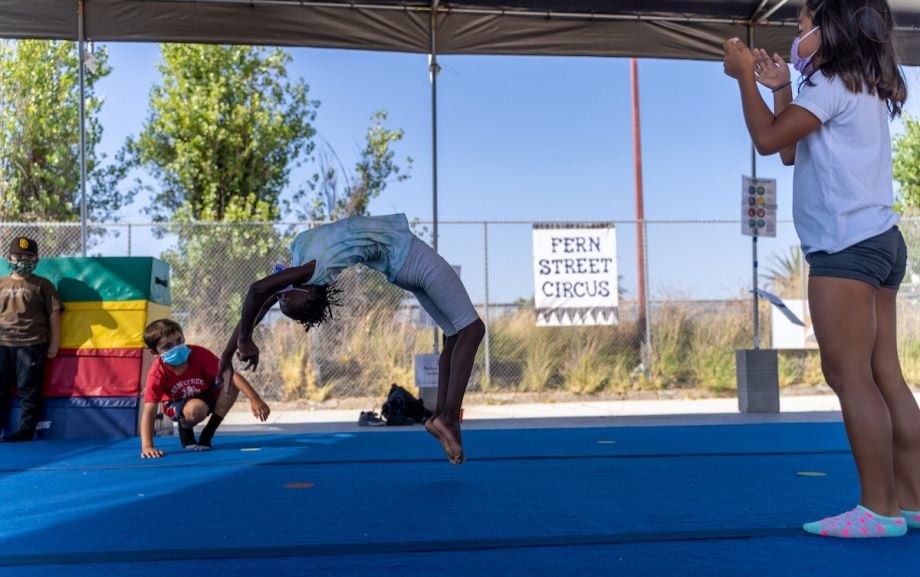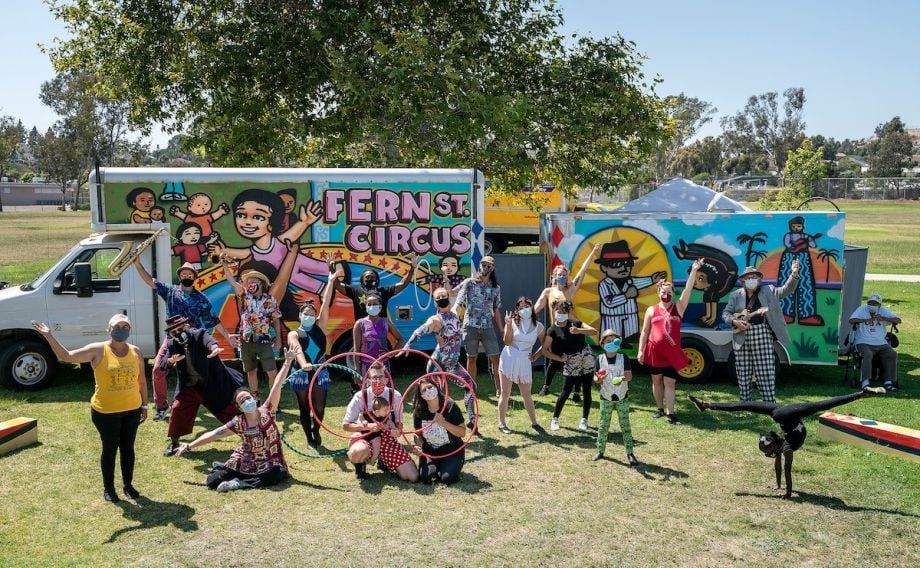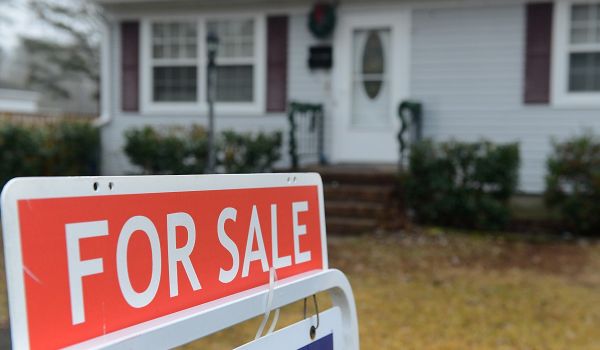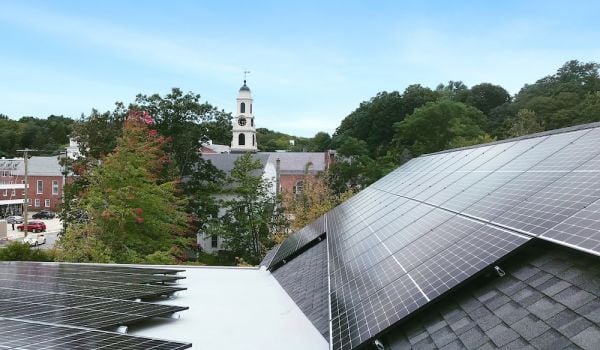The City Heights neighborhood of San Diego is known for its incredibly diverse community, including Latino, Vietnamese, Somali, Cambodian and Loatian residents. In addition to many murals and public art displays that reflect that diversity, there’s another, unexpected artist group that calls City Heights home: the Fern Street Circus, a project of the nonprofit Fern Street Community Arts.
The Fern Street Circus has two main outreach points. They run a thriving after-school circus program and they perform circus, variety and musical acts virtually, at their headquarters and in public parks throughout the region. Beyond entertainment, the circus connects attendees to critical resources such as housing, transportation and social services.
Musician and circus artist John Highkin co-founded Fern Street Circus in 1990 with public artist and art teacher Cindy Zimmerman, who is now his wife. They held their first single-ring circus show in September 1991 in San Diego’s Grape Street Park.
“I’ve been interested in theater that reaches people where they live. What I like about circus is that it doesn’t rely on language entirely,” Highkin says. “We’re a border town. We have a bilingual ringmaster, Memo Mendez, who is really funny and comes out of street theater (in Colombia and California). … We use the best of what circus can bring, and we speak to people in their own language, especially when we play in Spanish-language neighborhoods.”
Fern Street is part of a “social circus” movement to use circus arts as a medium for social justice and community development. They rarely charge for public community performances, in part because they’re based in the lowest-income neighborhood of the city with a high refugee population. They’ve also partnered with the county for Census outreach and hosted health fairs during performances.
Issues members of the community face regularly come up as themes in their performances. A few years ago, they put on a show about a clown who broke his funny bone but couldn’t afford to get it fixed without healthcare, a social security card or a credit card. COVID has also emerged as a theme, including through socially distanced performances at drive-through food distribution lines.

Nine-year-old Adama Bangoura practices her moves at Fern Street's after-school program.
Photo by Gary Payne
“Right now since the pandemic, we have a group of performers starting off in coveralls. And one of our clowns comes out with a giant needle and taps them and then they take their coveralls off to reveal colorful costumes,” Highkin says.
Fern Street hires skilled circus performers from around the world—including acrobat coach Idrissa Bangoura from Conakry, Guinea, whose 9-year-old daughter Adama performs with him—to both perform and provide City Heights students free lessons. Student groups then get to perform alongside adults.
“It’s a great way for them to feel more at ease and become part of the workforce,” Highkin says. “We’ve elevated students who have been with us two-and-a-half years to being featured in our show—two sisters on tightwire, and a young woman from Peru who is a remarkable dancer that does contortion.”
The youth programs can be life-changing for kids and parents alike. One such parent, Marcela Mercado, stumbled across the circus unexpectedly.
“I am a mother and resident in City Heights for 30 years,” she says. “On one walk in 2017, we were all a bit anxious looking for kids’ activities. I was holding my then 3-year-old son’s hand and went by Mid-City Gym and noticed people coming and going.”
Suddenly, the doors opened and something magical was happening inside. “Kids were laughing, playing and exercising, doing different circus activities with coaches and just having a good time with kids in the community,” she says
Mercado signed her three kids up. “When I say my kids are part of a circus, people are like, ‘circus, what is circus?’ There’s a lot of people that still don’t know what circus programs do, but the program has helped my family.”
She joined the board two years ago and was hired as general manager full-time in 2021. Currently, the circus serves around 30-35 kids in their Monday-Friday after-school program. Kids learn juggling, acrobatics, tightwire, cycling hoops and clowning.

Fern Street co-founder John Highkin poses with students who are part of Fern Street's after-school program. (Photo by Gary Payne)
Highkin has big dreams for the future of Fern Street. They are on a temporary lot that the City Heights Community Development Corporation (City Heights CDC) will later turn into affordable housing, but he hopes to have a circus community center that teaches music, dance and theater and can be both a performance space and a community resource. He would also like to expand their touring equipment so they can perform up and down the West Coast. Through it all, he wants to ensure they’re paying artists.
Currently, Highkin says they use multiple funding sources, from philanthropy to local grants or loans from organizations like City Heights CDC. They were also able to secure a PPP loan through the CDFI Self-Help Credit Union, which enabled them to hire teaching artists who were unemployed during COVID.
Highkin also intends to stay close to his original vision of inspiring social justice through art, which was inspired by studies of Bertoldt Brecht, whose theater in east Berlin—the Berliner Ensemble—he studied at. Instead of promoting escapism concerning Nazi Germany, Brecht portrayed reality, but with Verfremdungseffekt, distancing audiences enough to make people think.
“He was very political about overcoming social and economic injustice,” Highkin says. “He wanted people to think. We work very hard to keep it. We are really trying to make an impact on the people in our neighborhoods. I think we can do it.”

This story is part of our series, CDFI Futures, which explores the community development finance industry through the lenses of equity, public policy and inclusive community development. The series is generously supported by Partners for the Common Good. Sign up for PCG’s CapNexus newsletter at capnexus.org.
Hadassah Patterson has written for news outlets for more than a decade, contributing for seven years to local online news and with 15 years of experience in commercial copywriting. She currently covers politics, business, social justice, culture, food and wellness.




_920_518_600_350_80_s_c1.jpg)




_600_350_80_s_c1.jpg)






